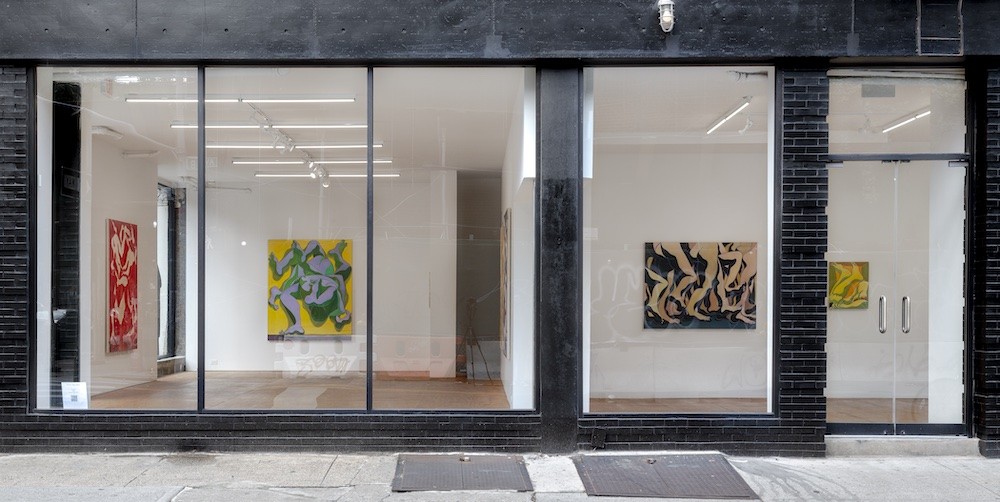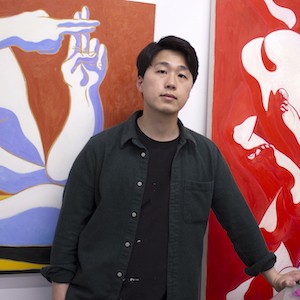Alumnus Mark Yang '20 in Solo Show at Half Gallery
Visual Arts alumnus Mark Yang ’20 engages flesh and masculinity in a solo show, Gymnós, at Half Gallery in New York City. This show will be on view from September 7 to October 7, 2022.
Visual Arts alumnus Mark Yang ’20 engages flesh and masculinity in a solo show, Gymnós, at Half Gallery in New York City. This show will be on view from September 7 to October 7, 2022.
Viewing paintings by Yang on the bright white walls of Half Gallery is a totalizing experience. The canvases are large, electrified from edge-to-edge with sharply colored limbs that stretch, leap, and collide. Seen on the gallery's website, the paintings appear contained, tightly packed with neon hues and electric lines, reminiscent of Alice Neel’s blue outlines, George Bellows’ boxers, and Matisse’s dancers. When witnessed in the flesh, however, all that associative cognition falls away. It is only the body that remains.
Take, for example, The Fall of the Rebel Angels 1 (72” x 56”, oil on canvas, 2022). Lean in close, say, half an arm’s length, and the two hands at the center seem to part, actively drawing you in. Rise to your toes, and suddenly you are ushered into a charged three-dimensional portal. Lean out a step or two, and the figures dissolve into neon crimson lines. Take a few steps further back, and the bodies become bodies to be looked at.
A particularly acute deftness of vision and skill is required to create such multilayered dynamism upon a canvas. Yang, who was a wrestler before he became a painter, draws within the lineage of Michaelangelo, and it shows; but something else is quickly apparent, too: Yang is not drawing bodies to be looked at and observed without complication. He is drawing flesh and dizzying motion, he is drawing the body as lived in, as moved with and within.
Standing before these works, one is compelled to answer their questions: What is a body on a canvas? What is a body on a wall? What is a body without a face? What is a body in a constant state of motion? The limbs pull and grab and leap towards each other, colliding and collapsing. The sheer physicality of these paintings overwhelms the space and confronts the viewer’s body directly. Yet the confrontation is nuanced and brilliantly complex, for despite their overt muscularity and hypnotic floatation upon layers of color, these bodies blur the edges of what can be directly known and answered about a body and a person.
By hyper focusing upon portions of limbs in motion—and there are so many limbs moving in these paintings—and rendering those limbs in colors you’d hardly encounter on anyone’s skin, Yang abstracts the body without effacing the body.
The impetus to work in this way was “a formal decision, where I began omitting the heads,” Yang told us. “Maybe the face hides behind the body, cut off from the edge, etc. You get labeled in life. I was getting labeled as the Asian guy painting Asian guys. I wanted to hide my identity somehow, so I started taking off the face and making the gender of the figures more or less ambiguous by omitting the genitals.”
It is precisely these omissions that form the crux of Yang's artistic eye. With graceful sincerity and unmediated vulnerability, one is invited to see differently, to see sensuality where one might step only as far as sexuality or merely physical eroticism. The paintings in Gymnós ask you to step further in, and they create numerous, almost playful portals through which to enter. The show is cheeky, it is euphoric, it is muscular, and it is one to see and to linger at for some time.
If you go, go at noon, when the light charges the space and creates a cathedral of alternate visions, visions that are felt and sensual, muscular and delightfully demonstrative.
Mark Yang (b. 1994, Seoul, South Korea) earned a B.F.A from Art Center College of Design ’17 and an M.F.A. from Columbia University ’20. Yang lives and works in Brooklyn, New York. Yang’s work is included in the public collections of the Mint Museum, Charlotte, North Carolina, the High Museum of Art, Atlanta, Georgia, and the Institute of Contemporary Art, Miami, Florida.
Battle of Constanine, detail, 57 1/2 x 47 1/2, oil on canvas, 2022. Photography by Daniel Terna / courtesy Half Gallery and the artist.
Arctic (night), 22 x 18, oil on canvas, 2021. Photography by Daniel Terna / courtesy Half Gallery and the artist.
Bodhisattvas, 72 x 60, oil on canvas, 2022. Photography by Daniel Terna / courtesy Half Gallery and the artist.
Yoga on a Table, 56 x 40, oil on canvas, 2022. Photography by Daniel Terna / courtesy Half Gallery and the artist.
Cadmium Red, 72 x 58, oil on canvas, 2022. Photography by Daniel Terna / courtesy Half Gallery and the artist.
The Fall of the Rebel Angels, 72 x 56, oil on canvas, 2022. Photography by Daniel Terna / courtesy Half Gallery and the artist.

